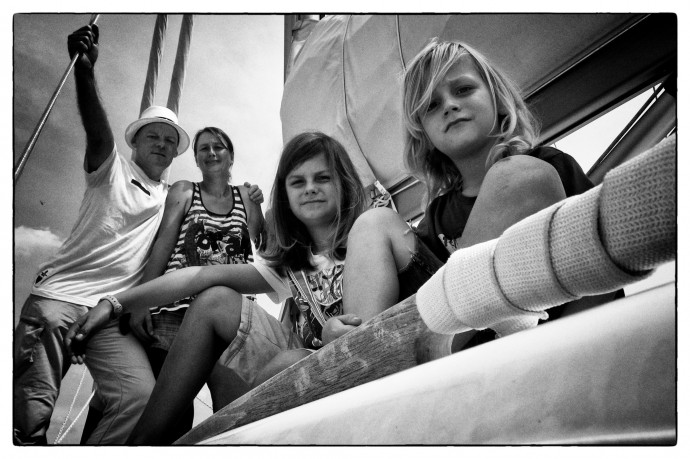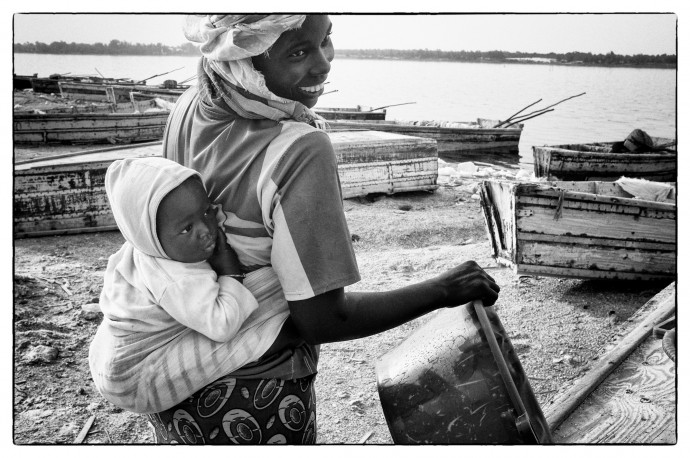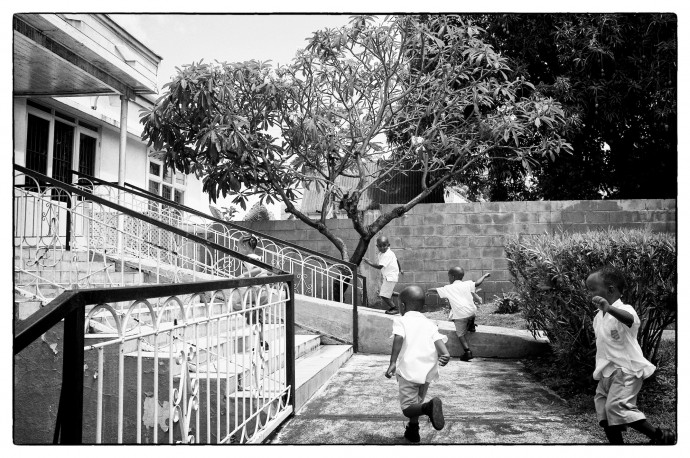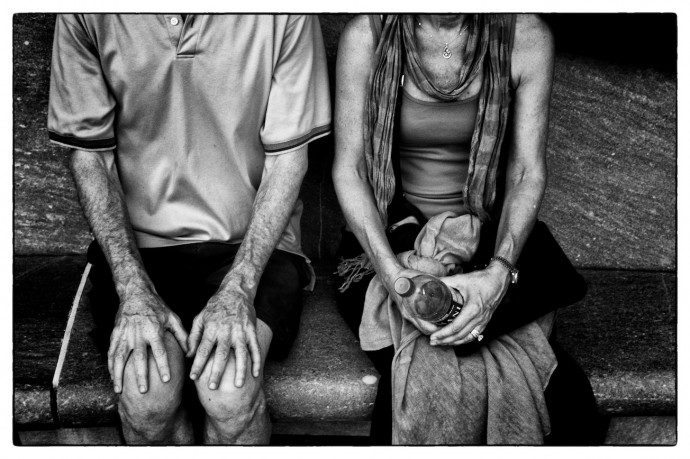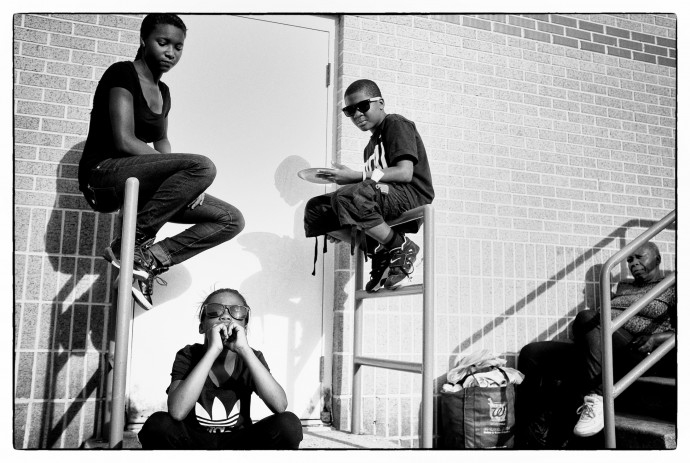Have you ever dreamed to leave everything behind and head on an extended trip across the Ocean ? Well, this is the adventure that street photographer Stéphane Lorcy and his family are currently experiencing on a sail ship around the Atlantic Ocean. In this interview, discover how the project was planned, daily life on board, and many considerations related to shooting street photography while traveling at sea. Finally, Stéphane who currently shoots with a Fuji X100, shares his first impressions on the new Leica M Monochrom that will accompany him for the remainder of the trip.
The pictures that illustrate this interview are part of a "Live together" series put together by Stéphane. (click on pictures for high res)
Stéphane and the family crew (Chris, Solal, Ulysse) aboard the Penn Gwen.
1) Tell us bit more about your 24 months around the Atlantic project.
In July of 2011, a sailing vessel named Penn Gwen, left France with 4 people on board : my wife Chris, my sons Ulysse and Solal, and myself. Our objective was to sail around the Atlantic Ocean for the next 2 years. I would also take the opportunity at each of our stops to grab my camera and go shoot street photography. In the beginning, my goal was to illustrate my travel website with the pictures along the way, especially since I have been a long time B&W white shooter. Nevertheless, my feelings started to change and I gradually became more ambitious about my body of work. Eventually, this led to the creation of The "Streets around the Ocean" project.
USA – Eat together
2) When I planned my own 80 weeks around the world trip, many people mentioned that they would also love to go on such an adventure. Yet, their job, kids, house, …, prevented them to do so. Since you are traveling with your whole family on a boat, can you tell us how you dealt with some of these concerns ?
We had lived in the Pacific Ocean, more specifically New Caledonia, for 3 years (2003-2006). But when we returned to France, we soon felt in need of a new adventure for our family. We therefore prepared this project over the next 5 years, which gave us the time to save money and let our children grow up a litlle more. Finally, I quit my job while my wife, who works in a public school, was able to apply for a leave of absence. My children are currently enrolled at CNED, a French distance school, and my wife acts as their every day teacher on the boat. All in all, if one believes that such a project is impossible, then it will probably end up so. Yet if one is convinced that it can be done, then the barriers to its achievement can be overcome. I guess it is often more reassuring to think about obstacles that prevent goals achievement, rather than to take the risks to go over them.
Cap Verde Islands – Generations together
3) Tell us about a typical day on your boat.
There are two very different routines when traveling on a boat. There is life at sea, and life during our stopovers (which represent most of our time). At sea, waves and wind take control our lives. We must maneuver the boat and stay on watch during the night. If the weather is good, then the kids study with their mother, otherwise they play, read or watch videos. During our stopovers, our life is not that different from the one we would have in a house. Every morning is dedicated to school, except for Sundays. During the afternoon, we pay visits to the areas or cities around the spot where our boat is anchored. Daily logistics can take a lot of time because we do not have a car and moorings can be far from cities. We regularly fill our water, diesel or gasoline tanks, as well as gas bottles. Laundry also takes significant time since we do not have a washing machine onboard. In the end, days go by quite quickly and the sun always sets too soon. Consequently, I can't really elect the time to go out and take pictures. I do it mainly during our walks, which is not always that easy as my family often ends up waiting for me. I have to thank them for their patience.
Senegal – Work together
4) Let's now talk about your street photography. How long have you been shooting and what are you goals for this trip ?
I started shooting around 20 years ago. I've always been a B&W shooter despite working on a contemporary art color project in New Caledonia. I would have preferred to shoot film during this trip yet the ordering and processing on a boat resulted too much of a task. Not to mention that the storage of film in a fridge would have been an extra challenge in terms of space and battery consumption. I therefore elected to shoot digital, and this with a 35mm fixed lens Fuji X100 as lone camera. Regarding my goals, which I am still trying to define them exactly, I would like to build a very simple and accessible panorama of the people that live around the Atlantic Ocean. I do not look for spectacular characters or situations, neither am I trying to tell anecdotes. I just want my photography to be factual, neutral but also simple and clear at the same time.
Madeira Island – Be together
5) Does traveling on a boat generate any particular challenges in terms of photography ?
I already mentioned that my main concern is to choose the time (and therefore light conditions) that I can be out there shooting in the streets. The presence of my family is the key element of this trip and I cannot put them at risk. My other challenges are above all about storage and back-ups. Indeed, the electronics become very fragile at sea due to the constant presence of salty air. This almost makes me become paranoid with my files and therefore I always try to take a hard drive on our walks. I even have a USB stick loaded with my B&W JPG's hanging around my neck at all time. As for cloud storage, this is pretty much a useless solution when you travel because of slow internet speeds (if any). For that reason, I shoot in JPG and the Fuji X100 resulted a great tool to produce excellent out of camera JPGs.
Antigua – School together
6) When viewing your pictures, I am particularly admiring of your talent for composition ? Can you tell us a bit more about it and define what you intend to convey with your pictures.
Thank you for this compliment which means a lot to me. I like simplicity and don't look for spectacular or funny situations. So, since the content is simple, form becomes very important. The scenes I depict must be organized in a way that let the eyes move easily around the image. Also, since my goal is to build an extensive panorama of places visited during this travel, I feel a strong urge to contextualize my pictures. To do so, I like introducing symbols like flags, monuments, cars, roads, houses, …, which ultimately allow to identify the time and place of the picture. My characters must somehow find a place in this context, this, without adding to much complexity to it. This being said, I also try to vary my pictures with an array of framings such as wide scenes, graphical images or portraits.
USA – Laugh together
7) You are a long time film shooter but had to switch to a digital camera for the convenience of the trip ? How does it impact the final rendering of your pictures?
Post processing is of little interest to me. I have tried to stick to a rendering that approximates the TRI X I used before. I like grain and always add it to my pictures because I am not particularly fond of the glossy rendering of digital pictures. Finally, I add a lens fall-off effect to my pictures, which basically recreates the way I was working in my darkroom.
Senegal – Out of work together
8) You will soon be the owner of a Leica Monochrom and already spent some limited time with it, any first impressions to share ?
As I already owned a Leica M6, getting started with the Monochrom was immediate and without any problems. I used it like a film camera, without ever going in the menu system or look at its screen (I often wait for several days before downloading my pictures). Compared to my M6, my main concern has been to deal with the digital noise. So far, the results seem to be incredible. The pictures out of the box are a bit flat but I think it's a good news since you can easily work with such files. Still, I'll probably have to adjust my post processing compared to the Fuji X100. Finally, exposure must be rigorous but this is no issue for a long time film shooter.
USA – Get old together
9) Cuba is your next destination, I am sure you are looking forward to reach that wonderful spot for street photography?
(laughs) No, actually you are wrong, and this since I looked at your pictures from Cuba. I think it was a mistake and I must now forget about your great colorful pictures. I want to enter Cuba with an immaculate mind so I try not to anticipate too much this destination. And since I'll take the Leica M Monochrom along, I will have no excuses. Still, I have a lot of hopes for this destination. This country is so close to the United States that it will inevitably change ones the current regime goes. I want to be able to shoot it before it happens.
Thank you Stéphane for sharing your time, pictures and adventures with us. The crew of the Penn Gwen is about to sail from Washington, heading to Cuba and the Carribean Sea. To follow, or know more about Stéphane and his street photography, please visit the following links:
